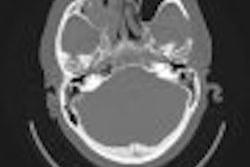While radiologists working in filmless departments don't experience degradation in visual acuity during the course of an average workday, a fraction of them may unknowingly be reading studies with less-than-perfect vision, according to researchers from the University of Maryland School of Medicine in Baltimore.
"Our results indicated no degradation of visual acuity among radiologists working in three filmless departments," said Dr. Nabile Safdar. "However, 21.7% of radiologists had a visual acuity of less than 20/20."
The practice of radiology involves sustained work at near distances, which requires both ocular accommodation and convergence. These processes may contribute to strain of the visual system, Safdar said. He presented the study team's research at the 2005 RSNA meeting in Chicago.
Many factors may conspire to stress the visual system for radiologists, including a rapidly increasing volume of images to interpret, an increasingly digital environment, and an increase in the amount of fatigue, he said.
To determine whether significant degradation occurs in the visual acuity of radiologists in the course of a day, the researchers surveyed radiologists from three large tertiary care hospitals. An intermediate distance (81.3 cm) Snellen visual acuity test was administered at three parts of the day, and radiologists also completed questionnaires covering age, ophthalmologic surgical or medical history, and the amount of sleep they had the previous night.
The average age of the participants was 45.6 years, and 69.5% used corrective lenses. Two respondents reported having eye surgery, one had a cataract removal, and one had Lasik surgery.
The average time from the last eye exam was 25.5 months, Safdar said. The mean corrected visual acuity for all radiologists at all sites was greater than 20/20, however, he said.
Also, no significant difference was found in mean visual acuity of radiologists measured during morning, midday, and afternoon. However, nearly 21.7% of radiologists had a visual acuity of less than 20/20, Safdar said. The visual acuities ranged from 20/30 to 20/12.5.
The average amount of sleep for radiologists was six hours and 45 minutes. Radiologists younger than 35 reported getting an average of 51 minutes less than that on the days their vision was being checked, Safdar said.
"Maybe this is because this is the group that was most likely to be on call in the centers we were doing the study at, but this prompted us to distribute a questionnaire asking (these radiologists) about their sleep time," he said.
The study team queried this group of 21 radiologists (average age of 29) if they have ever fallen asleep while driving after being on call overnight, and 28.5% reported they had, Safdar said. They also asked if they've experienced microsleeps (i.e., falling asleep briefly without realizing it) while reading a patient's study on call, and 46.7% reported they had.
When asked what percentage of radiology findings missed on call were related to lack of sleep, the mean reported response was 17.5%.
The researchers were surprised by some findings, including the 25.5 months average time from last eye exam, and that more than 20% of the radiologists in the study had less than 20/20 vision at an intermediate distance. In addition, almost half of radiology trainees surveyed in the study reported falling asleep while reading an imaging study on call, he said.
Safdar acknowledged some limitations in the study, including regulating the distance at which the visual acuity tests were performed. This may have discouraged presbyopes from participating, he said. In addition, it was a preliminary study with a limited number of participants.
Safdar stressed the importance of departments' encouraging their radiologists to maintain visual health with regular visits to an eye specialist. And for radiologists with extended work hours, sleep or the lack of it may alter the ability to interpret exams, he said.
"Both external and internal environments contribute to the whole radiology atmosphere and should be investigated as we seek to learn more about ideal radiology working conditions," Safdar said.
The researchers are collecting further data regarding the visual acuity of radiologists, and have begun preliminary efforts to better quantify the effects of sleep and other factors on the ability of radiologists to pay attention to imaging studies when they're tired and to maintain sustained vigilance, he said.
By Erik L. Ridley
AuntMinnie.com staff writer
December 29, 2005
Related Reading
Homegrown tool improves radiologists' workflow, December 16, 2005
Ergonomics -- It's all about you, November 23, 2005
Getting the most out of your PACS, August 29, 2005
PACS: Refining the human-machine interface, October 29, 2004
Copyright © 2005 AuntMinnie.com




















